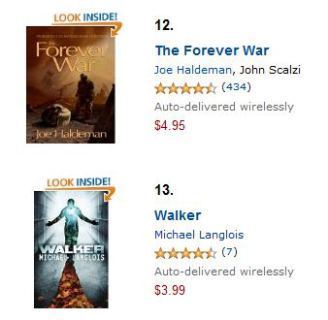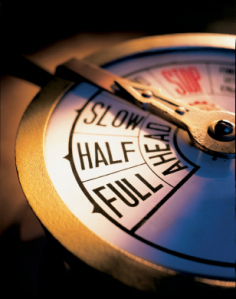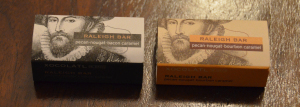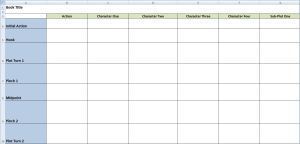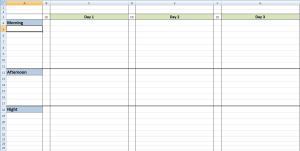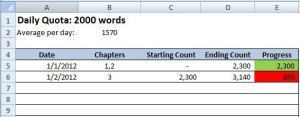Michael Langlois's Blog, page 12
February 12, 2012
Walker in Good Company on Sci-Fi Charts
You can tell I'm a huge nerd when I'm more exited to have my book listed next to The Forever War, than I am to be on the list in the first place.
Well, okay. That probably wasn't your first clue that I was a huge nerd. Shut up.
Filed under: Blog Posts








February 9, 2012
Finally, Zombie Specific Ammo
It's about time, Hornady. It's about time.
FYI, this is real ammo, from a real ammo manufacturer. Which is appropriate, considering that it's to be used in the very real, inevitable, zombie apocalypse.
Stock up now!

Filed under: Blog Posts








February 6, 2012
Working in the Word Mines – Pacing
When you first begin experiencing stories, either in books, movies, or other media, you become aware of pacing only when it's done incorrectly. You might complain that a movie dragged in the middle, or that at the end of a book you had no idea who half the characters were. And most of the time, you would have blamed these things on the content. The middle of the movie was slow because the content was boring. The characters were poorly written and not memorable. And while some of that might be true, the real culprit is in in the pacing.
You control pacing through both the information you deliver and how you deliver it. When the content and the delivery style are matched, you can achieve both breathless exhilaration or deeply engrossing immersion as you need them. These are the opposite ends of the pacing throttle, and you'll need both regardless of what kind of story you're writing.
Here's how to control your pacing:
Book Level: Scene vs Sequel
Pacing at a book level is determined by the ratio of scenes to sequels in a book. If you're not familiar with the terms, a scene is where the action takes place, and a sequel is where the characters react to that event and decide what to do next. For more detail, see Jim Butcher's excellent explanations here and here.
Typically you'll alternate scene-sequel for the length of the book. At a macro level, scenes increase the pace of the book and sequels slow it down. So for a thriller, you'll have more and longer scenes, and fewer or shorter sequels. For an epic fantasy, you'll have fewer scenes, and more elaborate sequels, and for romance you'll have very few scenes and lots of sequels. The key here is how much of the book is either scene verbiage or sequel verbiage, not the actual number of each.
Scene/Sequel Level: Action vs Description
Within a scene or sequel, you'll have both action and description. This is where most pacing errors appear. Action and description have opposite effects on pacing, so if you're writing a fast moving scene and you load it up with description, you can easily introduce drag. Yes, your outfit is very pretty. No, I don't care what kind of velvet it's made of during a fist fight.
On the other hand, if you describe your busy market or haunted house with a couple of terse sentences, your audience will feel rushed through the place with no real feel for the atmosphere you're trying to establish.
Be careful that you don't try to apply book-level pacing here. One mistake new writers tend to make is to decide that since they're writing a fast-paced thriller, the entire book should be made of short sentences with limited description. The book's pacing and the scene's pacing are very different things. Lots of scenes will increase the pace of the book, but within a scene you'll still need to establish setting and engage the reader's senses.
For books heavy on sequels, don't be afraid to cut the atmosphere and introspection during your scenes. Don't have the characters think about how that fiery confrontation is going to affect their relationship, just let them shout at each other in the heat of the moment, then think about it later.
Paragraph Level: Sentence Length
On an even smaller scale, you control the immediate, visceral sense of speed with sentence length and complexity. Short sentences with as few words as possible between the subject and the verb will increase the pace, while adjectives and clauses will slow things down. The rule about varying sentence length still stands, you will always need meter or rhythm to your sentences, so a fight scene should not consist of only three word sentences. But taken as a whole, paragraphs describing a fist fight should have noticeably shorter sentences on average than a paragraph describing a sunset.
As you vary your sentences, keep in mind a sense of dynamic tension. In a fight scene, longer sentences will help build a sense of anticipation, like the uphill sections of a roller coaster. For long descriptions, the occasional punchy section will keep the audience from feeling restless.
Regardless, there must always be a variation in pacing at this level. It's the subtle changing of pace that makes an impression on a reader, not the absolute pace. How boring would a roller coaster be if it were one long slope? A few minutes at a constant speed, and it feels like nothing is happening. The same is true for prose.
Pacing Tricks
Here are some specific tricks that you can use to bend the rules of pacing to get some interesting effects:
Slo-Mo: You know all that stuff I said about fight scenes having short, punchy sentences? Well, there's one instance where you should do exactly the opposite. At the decisive moment of impact in the scene, such as the final, terrible blow of a fight, the detonation of the hidden explosives, or the death-throes of the monster, stretch out your sentence length and turn up the descriptive prose. You can take a paragraph or more to describe those precious few seconds and create a slow-motion effect, where the audience can savor the moment. Used sparingly, this can really heighten the impact of your action scenes.
Snapshot: During a fast-paced scene, especially a longer one, you may need to bring the reader in close and ramp up the immersion factor. This is frequently done just before the climax of the scene to point out some important part of the plot. For example, the final punch of a fist-fight might mention the glint of light off of a wedding ring, or while a character is fleeing a burning building she might notice a photograph curling in the flames. The goal is to make the descriptive elements as short and vivid as possible, without stretching out the sentence length.
Travelogue: When you have a lot of description to do, try breaking up the prose with dialogue that adds personal context to the things you're describing. Lots of text describing buildings can get tedious fast, but a few sentences from a character about how when they were kids, they used to play right next to that slaughterhouse before they knew what it was, will pick things right up.
In the end, pacing is about contrast. The difference between a book that feels fast and a book that feels rushed is in the careful application of your slower, more immersive prose. In the same vein, the difference between rich and boring is in how skillfully you manage your action. Just keep things varied, and use the right technique for the right job. Once you understand the basics, it'll be easy to spot when you're going against the grain.
Filed under: Writing








January 30, 2012
No, Video Games. I Will Not Get in the Van.
If only there were somebody to send this letter to:
Dear Video Game Industry,
Please stop punching me in the discipline.
Thanks ever so much,
Mike
Let's face it. I'm a weak, weak man. When Skyrim came out, I wanted very badly to spend my days pretending to be a half-naked guy in the freezing cold wearing a metal hat with a couple of cow horns glued to it.
But, because I'm heroically dedicated (hahahaha), I managed to pull myself away. Well, dedicated in the sense that I very much want to avoid having virtual tomatoes thrown at me for missing my next deadline.
Then, immediately after my hard-won moral victory, Batman:Arkham City came out. Ouch. Wore tights for like, one night. Then I averted my eyes and put it away for good. I may have cried a little in the process, but it was still a victory, dammit.
Last month, my friends all started playing the new Star Wars MMO, The Old Republic. AND THEN THEY STARTED TELLING ME ABOUT IT. In breathless, exciting detail. I had to wrap them in duct tape and lock them in the closet, but it was worth it. Well, to me, anyway. Temptation avoided.
And now this. Gabe and Tycho are super awesome, but must they, too, try and lure me into the Unmarked Van of Slacking Off? Et Tu, Gaming Icons?
Kingdoms of Amalur launches next week. And the demo is out now. A demo in which you can get in-game items for the actual game. Just by playing it.
Sigh.
I swear I'll remain strong. No matter how long Gabe and Tycho sit in that damnable van outside, I'll be a rock. Just sitting there, honking the horn and revving the engine…
And cackling.
Filed under: Blog Posts








January 23, 2012
Bacon Caramel is Love
I know what you're thinking. "Mike, enough about writing already. WHAT ARE YOU PUTTING IN YOUR FACE RIGHT NOW?"
It's a fair question. The answer is this:
These little gems are physically about the same dimensions as a 'fun-size' candy bar, but taste-wise are about the size of a 1973 Buick Regal. Four words for you: pecan, nougat, caramel, bacon. Yeah. Oh, and the one on the left? Swap out the bacon and replace with bourbon. I know, right?
And, of course, the whole thing is smothered in the finest Ecuadorian dark chocolate.
So tasty. So hard to hide from the spouse and children. So impossible to explain to your doctor.
Seriously, if you have any love for caramel in your heart, get some of these.
Filed under: Blog Posts








January 15, 2012
Working in the Word Mines – Novel Planning Worksheet
This is the worksheet that I use for planning out my novels. One quick note: the first tab is based on the story structure that Dan Wells advocates, although I tend to play pretty fast and loose with his good advice. If you aren't familiar with this structure, I highly recommend following the link and checking it out.
As I've mentioned before, I use several different pieces of software during the creation of a novel, but this worksheet is in plain old Excel. You can get a copy here. If you don't have a copy of Excel (or equivalent), you can upload this to Google Docs for free and use it that way.
I'm in this worksheet daily, far more than any of my other tools. It helps me with four basic functions:
Overall Plot Structure
Tab one is where the big plot goes.
Column A, the blue one on the left, matches the story structure I'm using and lists the seven major steps that I want to keep track of for each story and character arc. Column B is for the main plot. This is where I'll jot down a quick note for each step of the primary story. You don't need much detail here. The other columns are for any character or sub-plot arcs that you have. This will be much more sparse, and you'll want to put them near the row that matches the main story arc where they happen. Take a look at the Dan Wells videos for more details on this. Also, this isn't carved in stone, feel free to put whatever plot markers you like in column A. The goal is just to have all your plot threads on one page.
Scenes
This is where I list out all of the scenes that I want to put in the book, in order. In the example workbook, you'll notice that there is a column for each day where those scenes would take place. There's no need to use a day structure, of course. You can use a single column with a long scene list, or break it up by parts of the book or plot. The goal is to lay them out in a way that's easy to look at so you can get a feel for the passage of events. Again, not much detail needs to go here. Think index cards. As you write, you'll be inserting or deleting scenes, which is why I like a spreadsheet for this. Also, notice that there is a small column called "Ch", where you can list the chapters that the scenes are actually in. Fill this out after you write the scene, so that you can quickly find it during later drafts. In many cases, I'll have an idea for a particular scene long after I write it, and this helps me not only find it, but also to remind me of the events surrounding it, just in case I'm about to screw up my plot.
Adds
These are revision notes. The first column is whether or not you've made the revision, the second is what chapter the revision is for, and the last column is for the actual note. I use this tab whenever I have an idea to implement later, to keep me from being sidetracked from the task at hand. I frequently think of something cool while writing chapter 20 which requires me to go back and put a gun/spaceship/baby doll in chapter 3. Instead of losing my train of thought, I just jot down a reminder here and then keep going. When it's time to revise, this is the first place I go. Note that after these changes are in, the resulting manuscript should still be considered first draft. Once that's done, then I start the second draft and use this tab again to note things that I see as I revise. Rinse, repeat.
Quota Tracking
Love, meet hate. Don't skip this tab. Use it, especially if you have a deadline. If you don't have a deadline, give yourself one, then use this tab. The first column is for the date. Never skip a date here. Ever. If you can't write that day, then your progress is zero, but it still needs to be noted. This serves two purposes. The first is that your average words per day are calculated correctly, and the second is that it provides motivation to get some words down in order to keep a writing streak alive. If you've made progress for a solid week or month, the last thing you want to do is drop in a big ol' zero. You can use whatever quota you like, but this tab is currently set for 2000 words a day. Enter in your starting count and ending count each day, and the progress column will automatically calculate your progress and turn the field green if you are at 2K or above, red if below.
The goal with this workbook is to have a quick and easy map of your book to work from. The plot tab is basically a big overview, the scene tab is a more detailed roadmap, and the last two tabs are to provide course corrections and to keep you moving. When you finish a scene, check to see what the next scene needs to be. If you get a great idea, take a quick look at where it fits in the existing structure. Need to chop something for length? Scan the scene list for organ donors. You'll be surprised how often you come back and check this road map during all stages of completion.
I use the hell out of this thing. It's made a big difference to me in terms of being on time and producing coherent plots, and I hope it does the same for you.
Filed under: Blog Posts








January 10, 2012
The Crazy Eye
I'm going to be pretty scarce this week, so to make up for it, here's a picture of my dog, Cher.
She's the very best dog in the world. And SMART, hoo boy, is she smart. But right here, in this picture, she's convinced that she can get this ball, which is a toy for horses, into her mouth.
Not gonna happen.
The look she has on her face? That's what we call, "The Crazy Eye".
That's the look you get when your complete dedication to a task is met by the utter refusal of the universe to cooperate. I'm pretty sure she learned it from me.
I'm going to stop this post now before I succumb to the temptation to make a bunch of ball swallowing jokes. See? 2012 is the year of mature restraint!
Filed under: Blog Posts








January 6, 2012
Risotto Balls are Best Balls
For game day last week I made some tasty, tasty arancini to snack on. This is where you improve anything risotto by deep frying it. They're lightly crunchy on the outside and creamy on the inside, and are kind of like starch heroin. Here's how to make your own.
Step 1 – The night before, make a nice batch of risotto. You can use the linked recipe, or if you're lazy like me, use this. It takes about 30 minutes, and is dead easy. At the end, add a nice handful of peccorino romano cheese. Let this cool and then refrigerate overnight. You'll want it to be cold and easy to work with.
Step 2 – Make some fatboy breadcrumbs. Take any bread you like, preferably something with a stiff crust, and roughly chop it in a food processor. You should end up with pieces the size of snowflakes.

This is right before Bob goes to the hot tub. See the size of the breadcrumbs?
Step 3 – Separate 2 or 3 eggs and put the whites in a bowl. You won't need the yolks.
Step 4 – Get some cold risotto out of your container and roll it into a ball. Traditionally these are about the size of a baseball, but I was making snacks, so mine are a little larger than a golf ball. Much easier to hold and game at the same time. Also, I like a higher crust to rice ratio, so smaller is better for me.
Step 5 – Dip your risotto ball in the egg white, then dredge in the bread crumbs. Let sit for about 30 seconds so the bread gets a chance to adhere.
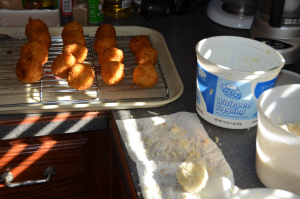
Risotto in the whip cream tub, fatboy breadcrumbs in the other, pre-fried arancini, finished balls of goodness
Step 6 – Fry! Use 350 degree oil for this. They'll be light and crispy, and by the time they are golden brown, the insides will be hot.
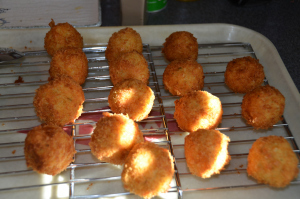
Done!

Bob the Arancini - our time together was too short.
These are super easy to make, and if you make the risotto and breadcrumbs the night before, you can fry them up half an hour before game time, easy.
Enjoy, and think of me next time you're clogging up your arteries with fried cheesy rice goodness!
Filed under: Blog Posts








January 5, 2012
Working in the Word Mines: Quotas
As you can probably tell from my release schedule, I work under some fairly tight deadlines. Luckily, I write pretty fast, so it hasn't turned into a total disaster. Yet.
But unless I get better about maintaining a consistent output, I really have very little control over the final completion date. So, in the spirit of 'you have to understand something before you can improve it', I've started tracking this year's daily output:

That's a lot of red for only 4 days. Sigh.
I have two goals here:
Maintain as close to a 2000 word per day average as possible
Maintain a continuous daily writing streak
There are a couple of things that aren't reflected in this chart. First, notice that the word count implies total work that day, so it appears that I was really slacking on the 2nd. In reality, I did a ton of re-writing on a scene I wasn't happy with. It just happened to come out slightly larger than the original. This entry could just as easily been negative.
Second, it doesn't account for time spent doing non-prose work, like plotting or research. I spent a significant amount of time on both the 2nd and the 4th on both of those things. So, even though I spent roughly the same amount of time working each day, my totals varied wildly.
My answer to that? Too bad. In the end, I need the book done by a certain date, and to do that, I need to put out at least so many words per day. The fact that plotting and research and re-writes take time is irrelevant. Nobody cares why a book is late, it's just late.
If you're not tracking your daily output, I highly suggest you give it a try. Even if you don't have a specific goal in mind, it's a great motivational tool to keep your ass in the chair. There's a big difference between the feeling that you're slacking and actually having to look at the proof.
One note about setting a number for the daily quota. After several books, I have a pretty good feel for what my pace is when I'm taking of business, so I set my quota accordingly. If you don't know what your pace is, just do the tracking and make sure you do some work every day. Do this for a month, and see what your average speed is. If you feel like you were hitting a good clip, use this as a starting quota. If you spent the time doing less than you wanted, raise it a bit and try it out.
In the end, the goal is to get consistent output, not to burn yourself out. Don't set the daily quota you wish you had and then kill yourself trying to meet it. Base it on your actual writing speed and tweak it later if needed.
Now beat it so I can work. I can't bear the thought of another one of those shameful red boxes.
Filed under: Blog Posts, Writing








January 3, 2012
From Foodzie with Love
Every year my family asks me what I want for Christmas. Or more specifically, what kind of weird nerd things that nobody else has ever heard of, that I want. And more often than not, that list turns out to be comprised primarily of stuff I can cram in my face. Eating is my one vice (HAHAHAHA), and if I'm going to get a present, it might as well be delicious.
If you haven't heard of it, Foodzie is an online retailer that specializes in totally amazing food from small shops and growers around the world. What they offer changes all the time, but it's always fantastic. It's also a bit on the spendy side, but the price is commiserate with the quality, I assure you. Still, I tend get things from them as gift items, rather than making it a regular thing.
Here's one of the things I got this year: the Butter Cup Collection from Ococoa:

Too delicious to describe. Also, now an empty box.
This is something I never would have even heard of if not for Foodzie. And yeah, every piece was a magical experience, like eating a fried unicorn rolled in chocolate.
Anyway, I just ate the last piece, so I figured I'd share the love with you. Notice that I offered to share the love, but I ate all the chocolate myself.
Sorry, but that's how I roll. SELFISHLY.
Filed under: Blog Posts









